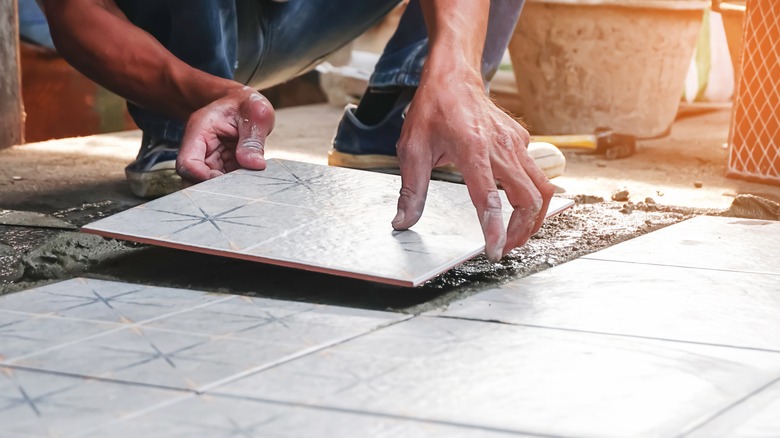Avoid Costly DIY Shower Tiling Mistakes By Creating A Template. Here's How
Any DIY-er knows that mistakes happen, especially when it comes to learning new skills. If you're giving your bathroom a fresh, clean aesthetic, cutting tile might be a daunting process, as one mistake can rack up your budget well beyond what you accounted for. With this simple trick, you can easily avoid those mistakes, keeping you and your wallet happy. All you need are a few yardsticks to get you started.
Gone are the days of individually laying and cutting tile, a process that can be both time-consuming and exhausting. Whether you're working with a tricky corner, plumbing fixtures, or awkwardly-shaped tile, you may find yourself needing a few extra pieces to account for any mistakes that you might make. Instead, why not opt for a simple DIY template made out of yardsticks to ensure you won't have any unforeseen expenses in your remodel process? And because they're so cheap, wooden yardsticks make the perfect budget-friendly material to craft your template. Simply build a wooden template that lays perfectly in your shower and use that as a guideline when cutting tiles. With this, you will be able to perfectly precut your shower tiles before you even start applying. And just like that, you've achieved the perfect fit for even the trickiest of showers, turning your DIY project into a pro job that saves you time and money.
Building a template
The trick to cutting tile just right is in the template itself. It allows you to account for those tricky fixtures and shapes without running the risk of redoing the entire project. To start off, grab your yardsticks and begin to lay them along the edges of your shower. You're essentially creating a framework for the bottom of your shower that you can easily remove to cut your tiles. Cut your sticks down to account for corners and slants before you begin gluing. You also want to make sure that you measure and mark your drain placement with a template that sits within the larger one. Once you have all of your pieces laid out, go ahead and glue the yardsticks to one another.
Arrange your tile on a flat surface, keeping in mind your desired design. Lay your built template over the top of the tile and use a pencil to trace around the edge. Take your grinder or saw and cut around the outer edge of your template. It is important to cut along the outer edge of your template to avoid any potential gaps between the shower wall and floor. Even when using a template, dry fitting your tile design can be an easy way to ensure that your template is accurate before you use any adhesive. Now you have perfectly cut panels of tile to apply to the bottom of your shower, cutting the cost of retiling your bathroom with this simple trick.
